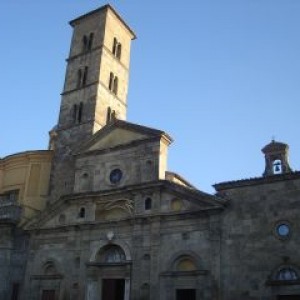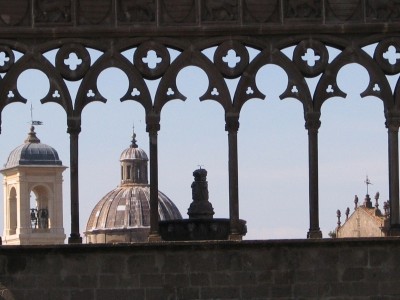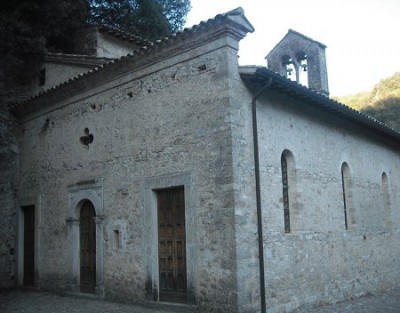Itineraries and mystical paths to the discovery of sacred places, churches and important historical and religious monuments.
Santa Cristina – Bolsena
In the footsteps of the Miracle, from Orvieto to Bolsena
A path that historically unites the two towns of common origin, Orvieto and Bolsena, which represent two landmarks of Bolsena Eucharistic miracle occurred, it is believed, between 1263 and 1264 in the town of Lazio when the consecrated host began to bleed during the celebration of the Mass by the priest Peter from Prague, who, it is said it was at that time doubtful about the real sacredness of the consecrated host and wine.
The blood exuded from the host stained both the marble and the altar stones that linen below, and today, Orvieto and Bolsena “divide” these two sacred relics, in fact in Bolsena, in the beautiful Church of Santa Cristina is a reliquary containing the table of marble stained by the blood and the sacred stones, while in Orvieto, in the Cathedral, specifically in the Chapel of the Corporal, houses the bloodstained linen (which is conducted every year and exhibited during the procession on the occasion of the feast Corpus Christi).
The route closely follows these places, in Bolsena, Santa Cristina is a large church that is located in the center of the country. It is impressive and inside in addition to that shrine, there are also the relics of Santa Cristina, the protector of the country, whose martyrdom every year “indicated” with the celebration of the Mysteries of Santa Cristina. Inside the church, also, on request you can also visit the underground where there are charming and ancient catacombs.
In Orvieto, instead, in the Cathedral you can admire the Chapel of the Corporal with its magnificent reliquary containing the sacred linen. The two cathedrals are places of worship on the occasion of the “Extraordinary Jubilee” held for the years 2013-2014.
Today, the famous and legendary path the sacred linen performed from Bolsena to Orvieto (from which comes the famous legend of the Sasso Cut that tells how, in front of the bullock cart carrying the sacred linen from Bolsena to Orvieto, at a location Buonviaggio huge boulder that hampered the path, magically split into two leaving the passage) is celebrated with a procession and a sporting event (relay).
Religious itineraries in Orvieto and its surrounding areas
Orvieto was an important Etruscan city and center of religious life of this great civilization as recent archaeological discoveries (in the Campo della Fiera) from which it is believed that at the foot of the cliff was present the well-known “Fanum Voltumnae”, the federal sanctuary Orvieto the Etruscan league… Other significant eras importance as related to religion city, especially during the period when it was subjected to the papal States. There are, in the city, places of worship, of course, all the magnificent Duomo, a wonderful architectural work and keeper of the sacred linen stained by the blood of Jesus on the occasion of the famous Eucharistic miracle of Bolsena. And it is precisely in the 2013-2014 biennium that Orvieto, returns to the center of religion, as a city of extraordinary Jubilee event to mark the 750th anniversary of the miracle of Bolsena and the institution of the feast of Corpus Christi.
For this and for its history, Orvieto offers numerous opportunities to anyone wishing to visit the holy sites of the city and follow some itineraries of faith in the surrounding territory by visiting beautiful places of worship of Christianity.
Religious Itinerary – Along the Via Francigena, from Orvieto to Viterbo
Palazzo Papale – Viterbo
A historical itinerary, which starts from the ancient route which in the past by numerous pilgrims from Canterbury leads to Rome. The Via Francigena, coming from the southern part of Tuscany, crosses Orvieto and then continues towards the Viterbo province in the direction of the capital.
The first step from Orvieto to Bolsena, the “strada del miracolo” where legend (known as the “Sasso Tagliato”) a large stone boulder opened the passage to papal procession while carrying from Bolsena to Orvieto the sacred stained linen on the occasion of the Eucharistic miracle.
In Bolsena, however, in the Cathedral of Santa Cristina it houses a reliquary containing the stained marble table from the blood other precious relic linked to the miracle. From Bolsena continue on the perimeter of the large lake coming to Montefiascone, who like Orvieto, was papal city as evidenced by the beautiful fortress of the Popes. In the center of the towns major cathedral of Santa Margherita which stands majestically with its large dome and San Flaviano.
A little more than ten kilometers is Viterbo, known as the City of the Popes for excellence with some points of the city of great interest such as the beautiful Papal Palace, the San Lorenzo church and the home of Santa Cristina. Viterbo was for a long time and a papal seat with ancient thermal baths (Terme dei Papi) that were much frequented by several popes.
The District of Orvieto, a land of monasteries, shrines and places of worship
Foto Gianmarco Fusari
Umbria is a land mystica and saints, St. Francis of Assisi is the main symbol in addition to other prominent figures such as San Benedetto in Norcia and Santa Rita in Cascia.
The Orvieto area is no exception, and as the whole region is full of sanctuaries, churches, monasteries; easily reachable from Orvieto in fact are the modern Sanctuary of Collevalenza, in Todi area and along the route near the Corbara lake, the Convent of Sant’Angelo in Pantanelli where there is a large tree that planted by St. Francis and the rock from which the saint preached to the fish.
Another mystical place in this ancient Pasquarella Hermitage. This place is full of mystery and legends, a wish that the structure was built on the site where it was found an image of the Madonna and the other has it that some inhabitants of the nearby village of Acqualoreto found this image took her in their church, but the image was then incredibly found on the bed of the ditch.
Another place of great charm and mystery of the convent of Scarzuola in Montegiove. A former Franciscan monastery where he also lived the saint of Assisi and his spirituality led the architect Tommaso Buzzi to build adjacent work the “ideal city” an artistic representation rich in allegorical meanings and symbolism.





